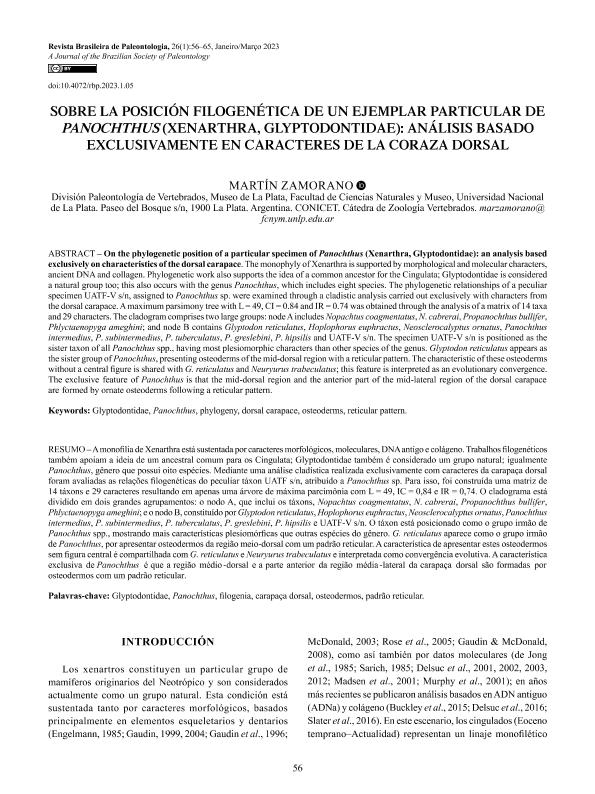Mostrar el registro sencillo del ítem
dc.contributor.author
Zamorano, Martín

dc.date.available
2024-01-03T12:02:34Z
dc.date.issued
2023-03
dc.identifier.citation
Zamorano, Martín; Sobre la posición filogenética de un ejemplar particular de Panochthus (Xenarthra, Glyptodontidae): análisis basado exclusivamente en caracteres de la coraza dorsal; Milchwissenschaft - Milk Science International; Revista Brasileira de Paleontologia; 26; 1; 3-2023; 56-65
dc.identifier.issn
1519-7530
dc.identifier.uri
http://hdl.handle.net/11336/222176
dc.description.abstract
The monophyly of Xenarthra is supported by morphological and molecular characters, ancient DNA and collagen. Phylogenetic work also supports the idea of a common ancestor for the Cingulata; Glyptodontidae is considered a natural group too; this also occurs with the genus Panochthus, which includes eight species. The phylogenetic relationships of a peculiar specimen UATF-V s/n, assigned to Panochthus sp. were examined through a cladistic analysis carried out exclusively with characters from the dorsal carapace. A maximum parsimony tree with L = 49, CI = 0.84 and IR = 0.74 was obtained through the analysis of a matrix of 14 taxa and 29 characters. The cladogram comprises two large groups: node A includes Nopachtus coagmentatus, N. cabrerai, Propanochthus bullifer, Phlyctaenopyga ameghini; and node B contains Glyptodon reticulatus, Hoplophorus euphractus, Neosclerocalyptus ornatus, Panochthus intermedius, P. subintermedius, P. tuberculatus, P. greslebini, P. hipsilis and UATF-V s/n. The specimen UATF-V s/n is positioned as the sister taxon of all Panochthus spp., having most plesiomorphic characters than other species of the genus. Glyptodon reticulatus appears as the sister group of Panochthus, presenting osteoderms of the mid-dorsal region with a reticular pattern. The characteristic of these osteoderms without a central figure is shared with G. reticulatus and Neuryurus trabeculatus; this feature is interpreted as an evolutionary convergence. The exclusive feature of Panochthus is that the mid-dorsal region and the anterior part of the mid-lateral region of the dorsal carapace are formed by ornate osteoderms following a reticular pattern.
dc.description.abstract
– A mono昀椀lia de Xenarthra está sustentada por caracteres morfológicos, moleculares, DNA antigo e colágeno. Trabalhos 昀椀logenéticos também apoiam a ideia de um ancestral comum para os Cingulata; Glyptodontidae também é considerado um grupo natural; igualmente Panochthus, gênero que possui oito espécies. Mediante uma análise cladística realizada exclusivamente com caracteres da carapaça dorsal foram avaliadas as relações 昀椀logenéticas do peculiar táxon UATF s/n, atribuído a Panochthus sp. Para isso, foi construída uma matriz de 14 táxons e 29 caracteres resultando em apenas uma árvore de máxima parcimônia com L = 49, IC = 0,84 e IR = 0,74. O cladograma está dividido em dois grandes agrupamentos: o nodo A, que inclui os táxons, Nopachtus coagmentatus, N. cabrerai, Propanochthus bullifer, Phlyctaenopyga ameghini; e o nodo B, constituído por Glyptodon reticulatus, Hoplophorus euphractus, Neosclerocalyptus ornatus, Panochthus intermedius, P. subintermedius, P. tuberculatus, P. greslebini, P. hipsilis e UATF-V s/n. O táxon está posicionado como o grupo irmão de Panochthus spp., mostrando mais características plesiomór昀椀cas que outras espécies do gênero. G. reticulatus aparece como o grupo irmão de Panochthus, por apresentar osteodermos da região meio-dorsal com um padrão reticular. A característica de apresentar estes osteodermos sem 昀椀gura central é compartilhada com G. reticulatus e Neuryurus trabeculatus e interpretada como convergência evolutiva. A característica exclusiva de Panochthus é que a região médio -dorsal e a parte anterior da região média -lateral da carapaça dorsal são formadas por osteodermos com um padrão reticular.
dc.format
application/pdf
dc.language.iso
spa
dc.publisher
Milchwissenschaft - Milk Science International

dc.rights
info:eu-repo/semantics/openAccess
dc.rights.uri
https://creativecommons.org/licenses/by/2.5/ar/
dc.subject
DORSAL CARAPACE
dc.subject
GLYPTODONTIDAE
dc.subject
OSTEODERMS
dc.subject
PANOCHTHUS
dc.subject
PHYLOGENY
dc.subject
RETICULAR PATTERN
dc.subject.classification
Paleontología

dc.subject.classification
Ciencias de la Tierra y relacionadas con el Medio Ambiente

dc.subject.classification
CIENCIAS NATURALES Y EXACTAS

dc.title
Sobre la posición filogenética de un ejemplar particular de Panochthus (Xenarthra, Glyptodontidae): análisis basado exclusivamente en caracteres de la coraza dorsal
dc.title
On the phylogenetic position of a particular specimen of Panochthus (Xenarthra, Glyptodontidae): an analysis based exclusively on characteristics of the dorsal carapace
dc.type
info:eu-repo/semantics/article
dc.type
info:ar-repo/semantics/artículo
dc.type
info:eu-repo/semantics/publishedVersion
dc.date.updated
2023-12-27T17:37:58Z
dc.journal.volume
26
dc.journal.number
1
dc.journal.pagination
56-65
dc.journal.pais
Brasil

dc.journal.ciudad
Porto Alegre
dc.description.fil
Fil: Zamorano, Martín. Universidad Nacional de La Plata. Facultad de Ciencias Naturales y Museo. División Paleontología Vertebrados; Argentina. Consejo Nacional de Investigaciones Científicas y Técnicas. Centro Científico Tecnológico Conicet - La Plata; Argentina
dc.journal.title
Revista Brasileira de Paleontologia

dc.relation.alternativeid
info:eu-repo/semantics/altIdentifier/url/https://sbpbrasil.org/publications/index.php/rbp/article/view/331
dc.relation.alternativeid
info:eu-repo/semantics/altIdentifier/doi/http://dx.doi.org/10.4072/rbp.2023.1.05
Archivos asociados
